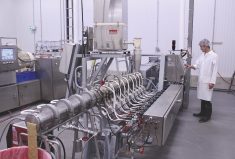Since food and beverage processors are the largest buyers of agricultural production in Canada, purchasing about 40 per cent of domestic farmers’ agricultural output, growth in domestic processing couldn’t help but be positive for farmers.
At least, that’s the growing consensus in more university business faculties and in the head offices of more business associations.
“It has to be,” says Sylvain Charlebois, director of Dalhousie University’s Agri-Food Analytics Lab.
Read Also

Is your parents’ accountant the best fit for the farm?
https://www.youtube.com/shorts/D3DJQxJROoU How can you tell your parents that the accountant they’ve had for years might not currently be the best…
“It has to be critical for farmers to see manufacturing grow in this country as much as possible.”
Farmers are vulnerable as price takers, he argues, so a stronger food processing industry with more processors and more buyer options will make farms stronger too.
There would also be other benefits. Growth in domestic processing would also reduce transportation costs. Western grain farmers in particular ring up big bills on freight costs to the west coast that would be eased if they sold more of their output to local processors.
- Read more: Home field advantage
Rail car availability
Keith Currie, first vice-president of the Canadian Federation of Agriculture (CFA), says other risk factors would also be eliminated or reduced with more local buyer options.
For instance, farmers would be less exposed to rail lines going out of service due to weather or derailment, and there would be less risk of big demurrage costs when ships at ports await late grain shipment — costs that grain companies pass along to producers.
There are also advantages to direct selling to end users.
“In the horticulture sector in B.C., Quebec and Ontario in particular, a lot of greenhouse growers contract directly with Walmart, Costco, Loblaws, etc.,” Currie says. “That direct connect gives farmers a lot more control of their product, and a lot more certainty that their product’s going to move.”
Premiums for locally sourced agricultural production may be another generator of better prices.
It all makes too much sense to ignore, more industry watchers say. Agricultural Producers Association of Saskatchewan (APAS) president Todd Lewis, for instance, says Canada’s sustainable reputation should be a selling point for processors.
“It’s an opportunity for our food processors to use Canadian-sourced products and sell them internationally to a world looking for more and more sustainable type of agriculture,” Lewis says.
Friction
Despite obvious shared values and the co-dependence of farmers and processors, though, they don’t always feel like they’re on the same side. Far from it.
“There’s always been some tension within the supply chain,” says Charlebois.
Part of it is due to a lack of understanding or appreciation of what goes on in the entire supply chain, he says. Processing isn’t easy, and numerous market dynamics exist at every node.
Money, too, plays a huge part in divisions. “Whenever you have a transaction where money is involved, there is going to be tension,” says University of Manitoba ag dean Martin Scanlon.
But it goes beyond each side trying to get the best price.
Scanlon says schemes to assure consumers of food safety aren’t well supported financially by farmers, in part because they typically cause additional paperwork and reporting that’s often of no direct relevance to farm operations.
“Often retailers are the ones driving tension points between processors and farmers since they impose a no-price-increase requirement on the processor, who in turn imposes it on the farmers that supply them with raw materials,” Scanlon says.
Farmers can also be sources of discord.
“I know in the past of a farmer who started processing and was required to leave the producer board she sat on,” Scanlon says.
He also recalls a resolution passed at APAS’s 2016 annual general meeting that supported the concept that federal and provincial governments’ agriculture funding be dedicated to supporting primary agriculture rather than value-added processing.
“This speaks to the sometimes-adversarial relationship,” Scanlon says.
APAS’s Lewis describes current relations between farmers and food processors as evolving, with a growing amount of collaboration and understanding between the two.
“More and more it’s being recognized producers have to have an economically sustainable model — as well as food processors — and if we’re going to have a domestic food processing industry, we’re going to have to have a relationship between producers and food processors that’s more of a partnership than something adversarial,” Lewis says.
Need to work together
Common issues in particular need both parties on the same side. “With all the challenges coming to the industry, like labour and climate change, there are so many headwinds, you have to work together,” says Charlebois. “You can’t really resolve some of these complex issues on your own.”
But he doesn’t believe there’s enough trust between the two. “A crisis will either separate them even more or force them to work together, but we shouldn’t wait for a crisis to happen,” Charlebois says.
Consumers may be the ideal place to start in improving relations.
“Understand the consumer, where things are going, and work your way back. That’s the best way to do it,” Charlebois says.
Currie adds that because consumer demands are ever-changing, processors “are going to have to be a lot nimbler in how they work with the farm community to make sure that the product they require is available.”
Positive signs
Currie adds that sustainability issues, particularly climate change, will require a strong relationship in the value chain.
“Because if one is suffering, they’re all going to end up suffering,” he says. “The more we can partner with our friends up the value chain, the better it will be for the farmers on the ground going forward.”
One concrete collaborative step to tackle the sustainability issue is the National Index on Agri-Food Performance. Currie says CFA is working on the initiative with numerous partners, and hopes to have it in place by the end of next year.
“Sustainability is at the crux of it, and it’s got the entire value chain involved, from farm to retail,” Currie says.
Michael Graydon, CEO of Food, Health & Consumer Products of Canada (FHCP), says there’s more trust and opportunities “than ever before” for farmers and processors to work together on common issues.
He notes FHCP has formal partnerships with CFA, on top of “well-established links” with provincial groups.
One issue they’re dealing with is the power imbalance of grocery retailers in Canada, where only five retailers control 80 per cent of grocery sales. They’ve raised fees to get products on their store shelves and keep them there by more than 20 per cent in recent years, while fees in the U.S. have remained flat, Graydon says.
The concept of a Grocery Supply Code of Practice isn’t new, but previous efforts always fell flat. Now the dam seems to have been broken. “It wasn’t until FHCP partnered with Sobey’s on a proposed code, which then led to clear support from farm groups,” Graydon says. “It’s expected next spring. That’s the power of partnership.”
















